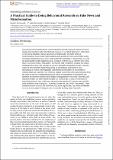| dc.contributor.author | Pennycook, Gordon | |
| dc.contributor.author | Binnendyk, Jabin | |
| dc.contributor.author | Newton, Christie | |
| dc.contributor.author | Rand, David G | |
| dc.date.accessioned | 2022-08-08T15:15:26Z | |
| dc.date.available | 2022-08-08T15:15:26Z | |
| dc.date.issued | 2021 | |
| dc.identifier.uri | https://hdl.handle.net/1721.1/144265 | |
| dc.description.abstract | <jats:p>Coincident with the global rise in concern about the spread of misinformation on social media, there has been influx of behavioral research on so-called “fake news” (fabricated or false news headlines that are presented as if legitimate) and other forms of misinformation. These studies often present participants with news content that varies on relevant dimensions (e.g., true v. false, politically consistent v. inconsistent, etc.) and ask participants to make judgments (e.g., accuracy) or choices (e.g., whether they would share it on social media). This guide is intended to help researchers navigate the unique challenges that come with this type of research. Principle among these issues is that the nature of news content that is being spread on social media (whether it is false, misleading, or true) is a moving target that reflects current affairs in the context of interest. Steps are required if one wishes to present stimuli that allow generalization from the study to the real-world phenomenon of online misinformation. Furthermore, the selection of content to include can be highly consequential for the study’s outcome, and researcher biases can easily result in biases in a stimulus set. As such, we advocate for pretesting materials and, to this end, report our own pretest of 224 recent true and false news headlines, both relating to U.S. political issues and the COVID-19 pandemic. These headlines may be of use in the short term, but, more importantly, the pretest is intended to serve as an example of best practices in a quickly evolving area of research.</jats:p> | en_US |
| dc.language.iso | en | |
| dc.publisher | University of California Press | en_US |
| dc.relation.isversionof | 10.1525/COLLABRA.25293 | en_US |
| dc.rights | Creative Commons Attribution 4.0 International license | en_US |
| dc.rights.uri | https://creativecommons.org/licenses/by/4.0/ | en_US |
| dc.source | University of California Press | en_US |
| dc.title | A Practical Guide to Doing Behavioral Research on Fake News and Misinformation | en_US |
| dc.type | Article | en_US |
| dc.identifier.citation | Pennycook, Gordon, Binnendyk, Jabin, Newton, Christie and Rand, David G. 2021. "A Practical Guide to Doing Behavioral Research on Fake News and Misinformation." Collabra: Psychology, 7 (1). | |
| dc.contributor.department | Sloan School of Management | |
| dc.contributor.department | Massachusetts Institute of Technology. Institute for Data, Systems, and Society | |
| dc.contributor.department | Massachusetts Institute of Technology. Department of Brain and Cognitive Sciences | |
| dc.relation.journal | Collabra: Psychology | en_US |
| dc.eprint.version | Final published version | en_US |
| dc.type.uri | http://purl.org/eprint/type/JournalArticle | en_US |
| eprint.status | http://purl.org/eprint/status/PeerReviewed | en_US |
| dc.date.updated | 2022-08-08T15:11:26Z | |
| dspace.orderedauthors | Pennycook, G; Binnendyk, J; Newton, C; Rand, DG | en_US |
| dspace.date.submission | 2022-08-08T15:11:27Z | |
| mit.journal.volume | 7 | en_US |
| mit.journal.issue | 1 | en_US |
| mit.license | PUBLISHER_CC | |
| mit.metadata.status | Authority Work and Publication Information Needed | en_US |
